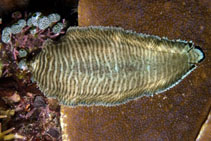
|
Soleichthys heterorhinos (Bleeker, 1856) Black-tip sole |

|
|
photo by
Malaer, P. |
| Family: | Soleidae (Soles) | |||
| Max. size: | 18 cm SL (male/unsexed) | |||
| Environment: | reef-associated; marine; depth range 0 - 10 m | |||
| Distribution: | Eastern Indian Ocean and Western Pacific: India to Samoa, north to southern Japan, south to New South Wales, Australia. | |||
| Diagnosis: | Dorsal spines (total): 0-0; Dorsal soft rays (total): 87-102; Anal spines: 0-0; Anal soft rays: 72-87; Vertebrae: 50-50. Description: Characterized by adult with white to tan brown color with numerous dark brown lines or narrow bars across body and dorsal and anal fins; dorsal and anal fins with white margin and broad blue to blackish submarginal zone; pale caudal fin with black outer border; branched pectoral rays on eyed side 7-9, on blind side 6-8; ctenoid scales; elongate body, greatest depth 2.7-3.5 in SL; head length 6.0-6.8 in SL; small eyes and nearly continuous (minimal interorbital space); tubular anterior nostril longer than eye; ventral edge of head with fringe of cirri (Ref. 90102). | |||
| Biology: | Occurs in shallow protected sandy areas of lagoon and seaward reefs. Buries itself beneath the sand, exposing only its eye and tubular nostril. Moves extremely fast when disturbed and is difficult to detect when it resettles. Apparently more active at night (Ref. 1602, 48637). | |||
| IUCN Red List Status: | Least Concern (LC); Date assessed: 04 March 2015 Ref. (130435) | |||
| Threat to humans: | harmless | |||